Economic Effects of COVID-19 Pandemic and Inflation in India
VerifiedAdded on 2021/09/18
|14
|3503
|166
Report
AI Summary
This report, prepared by a SYBA student, examines the economic effects of the COVID-19 pandemic on India, with a specific focus on whether the pandemic caused inflation. It begins with an introduction to the global health and economic shocks caused by the pandemic, followed by an overview of the Indian economy before the outbreak, highlighting slowing GDP growth and rising unemployment. The report then delves into the impact of the pandemic on inflation, macroeconomic effects such as demand and supply disruptions, and the long-run consequences of the economic disturbance, including disruptions in the accumulation of physical and human capital. The analysis covers various aspects like the decline in private consumption, investment, international trade, and manufacturing, providing a comprehensive view of the pandemic's impact on different sectors of the Indian economy. The report also considers the role of government and the Reserve Bank of India (RBI) in mitigating the crisis.
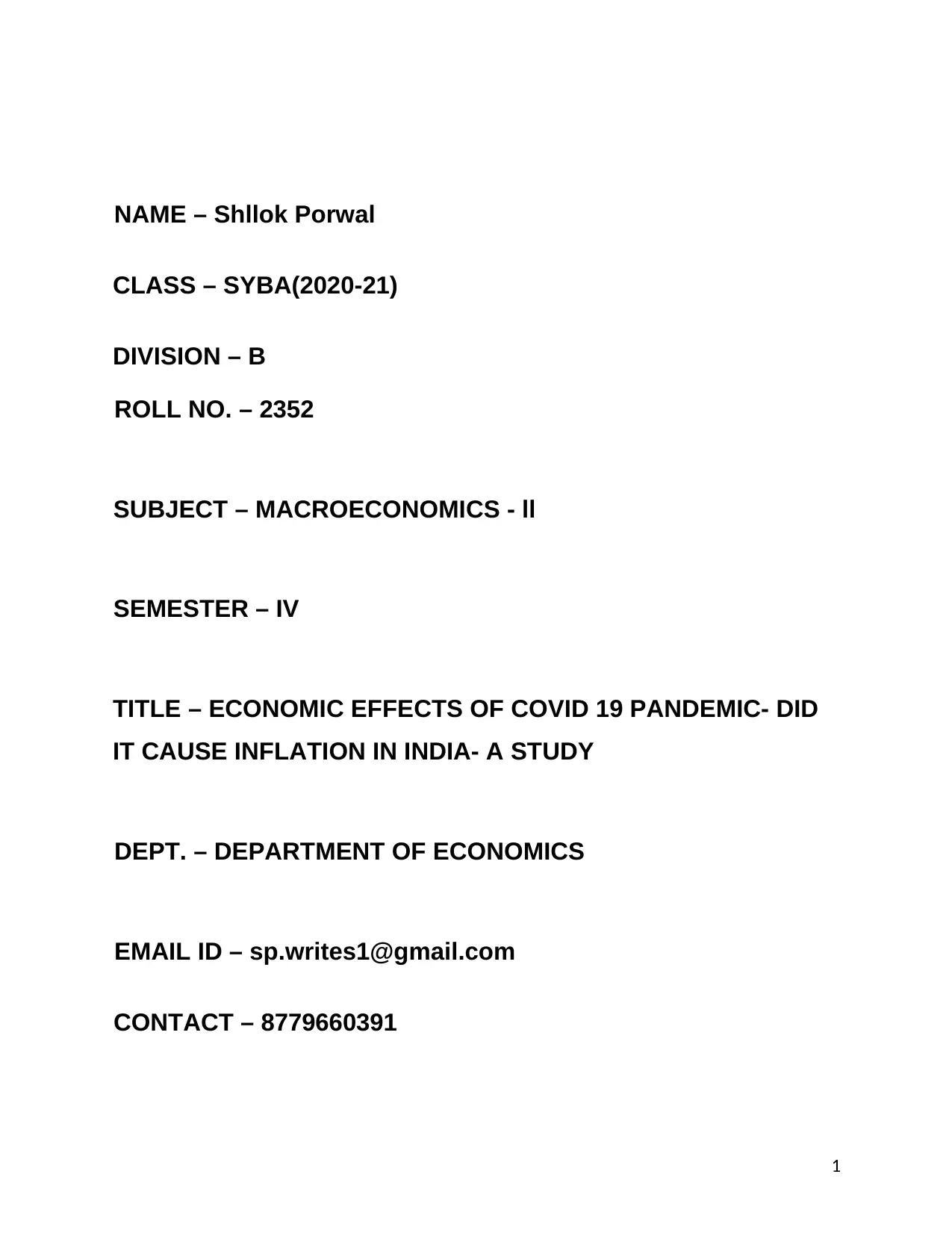
1
NAME – Shllok Porwal
CLASS – SYBA(2020-21)
DIVISION – B
ROLL NO. – 2352
SUBJECT – MACROECONOMICS - ll
SEMESTER – IV
TITLE – ECONOMIC EFFECTS OF COVID 19 PANDEMIC- DID
IT CAUSE INFLATION IN INDIA- A STUDY
DEPT. – DEPARTMENT OF ECONOMICS
EMAIL ID – sp.writes1@gmail.com
CONTACT – 8779660391
NAME – Shllok Porwal
CLASS – SYBA(2020-21)
DIVISION – B
ROLL NO. – 2352
SUBJECT – MACROECONOMICS - ll
SEMESTER – IV
TITLE – ECONOMIC EFFECTS OF COVID 19 PANDEMIC- DID
IT CAUSE INFLATION IN INDIA- A STUDY
DEPT. – DEPARTMENT OF ECONOMICS
EMAIL ID – sp.writes1@gmail.com
CONTACT – 8779660391
Paraphrase This Document
Need a fresh take? Get an instant paraphrase of this document with our AI Paraphraser

2
INDEX
SR. NO. TOPIC PAGE NO.
1 INTRODUCTION 3
2 THE STATE OF THE INDIAN ECONOMY ON THE EVE OF
COVID-19 OUTBREAK
5
3 INFLATION IN INDIA AND COVID 19 8
4 MACROECONOMIC EFFECTS 9
5 ECONOMIC EFFECTS OF THE PANDEMIC IN THE LONG RUN 11
6 CONCLUSION 13
7 REFERNECES 14
INDEX
SR. NO. TOPIC PAGE NO.
1 INTRODUCTION 3
2 THE STATE OF THE INDIAN ECONOMY ON THE EVE OF
COVID-19 OUTBREAK
5
3 INFLATION IN INDIA AND COVID 19 8
4 MACROECONOMIC EFFECTS 9
5 ECONOMIC EFFECTS OF THE PANDEMIC IN THE LONG RUN 11
6 CONCLUSION 13
7 REFERNECES 14
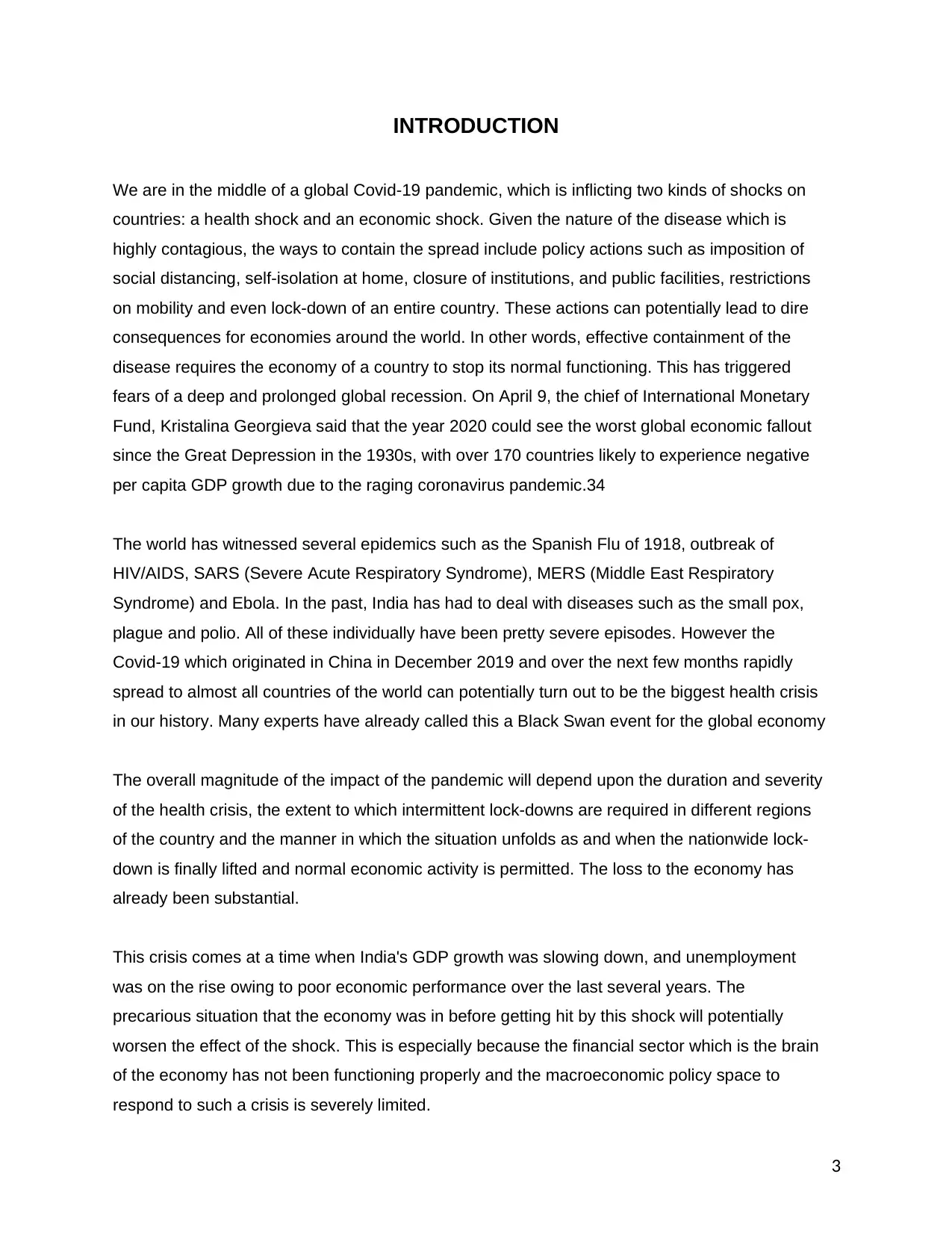
3
INTRODUCTION
We are in the middle of a global Covid-19 pandemic, which is inflicting two kinds of shocks on
countries: a health shock and an economic shock. Given the nature of the disease which is
highly contagious, the ways to contain the spread include policy actions such as imposition of
social distancing, self-isolation at home, closure of institutions, and public facilities, restrictions
on mobility and even lock-down of an entire country. These actions can potentially lead to dire
consequences for economies around the world. In other words, effective containment of the
disease requires the economy of a country to stop its normal functioning. This has triggered
fears of a deep and prolonged global recession. On April 9, the chief of International Monetary
Fund, Kristalina Georgieva said that the year 2020 could see the worst global economic fallout
since the Great Depression in the 1930s, with over 170 countries likely to experience negative
per capita GDP growth due to the raging coronavirus pandemic.34
The world has witnessed several epidemics such as the Spanish Flu of 1918, outbreak of
HIV/AIDS, SARS (Severe Acute Respiratory Syndrome), MERS (Middle East Respiratory
Syndrome) and Ebola. In the past, India has had to deal with diseases such as the small pox,
plague and polio. All of these individually have been pretty severe episodes. However the
Covid-19 which originated in China in December 2019 and over the next few months rapidly
spread to almost all countries of the world can potentially turn out to be the biggest health crisis
in our history. Many experts have already called this a Black Swan event for the global economy
The overall magnitude of the impact of the pandemic will depend upon the duration and severity
of the health crisis, the extent to which intermittent lock-downs are required in different regions
of the country and the manner in which the situation unfolds as and when the nationwide lock-
down is finally lifted and normal economic activity is permitted. The loss to the economy has
already been substantial.
This crisis comes at a time when India's GDP growth was slowing down, and unemployment
was on the rise owing to poor economic performance over the last several years. The
precarious situation that the economy was in before getting hit by this shock will potentially
worsen the effect of the shock. This is especially because the financial sector which is the brain
of the economy has not been functioning properly and the macroeconomic policy space to
respond to such a crisis is severely limited.
INTRODUCTION
We are in the middle of a global Covid-19 pandemic, which is inflicting two kinds of shocks on
countries: a health shock and an economic shock. Given the nature of the disease which is
highly contagious, the ways to contain the spread include policy actions such as imposition of
social distancing, self-isolation at home, closure of institutions, and public facilities, restrictions
on mobility and even lock-down of an entire country. These actions can potentially lead to dire
consequences for economies around the world. In other words, effective containment of the
disease requires the economy of a country to stop its normal functioning. This has triggered
fears of a deep and prolonged global recession. On April 9, the chief of International Monetary
Fund, Kristalina Georgieva said that the year 2020 could see the worst global economic fallout
since the Great Depression in the 1930s, with over 170 countries likely to experience negative
per capita GDP growth due to the raging coronavirus pandemic.34
The world has witnessed several epidemics such as the Spanish Flu of 1918, outbreak of
HIV/AIDS, SARS (Severe Acute Respiratory Syndrome), MERS (Middle East Respiratory
Syndrome) and Ebola. In the past, India has had to deal with diseases such as the small pox,
plague and polio. All of these individually have been pretty severe episodes. However the
Covid-19 which originated in China in December 2019 and over the next few months rapidly
spread to almost all countries of the world can potentially turn out to be the biggest health crisis
in our history. Many experts have already called this a Black Swan event for the global economy
The overall magnitude of the impact of the pandemic will depend upon the duration and severity
of the health crisis, the extent to which intermittent lock-downs are required in different regions
of the country and the manner in which the situation unfolds as and when the nationwide lock-
down is finally lifted and normal economic activity is permitted. The loss to the economy has
already been substantial.
This crisis comes at a time when India's GDP growth was slowing down, and unemployment
was on the rise owing to poor economic performance over the last several years. The
precarious situation that the economy was in before getting hit by this shock will potentially
worsen the effect of the shock. This is especially because the financial sector which is the brain
of the economy has not been functioning properly and the macroeconomic policy space to
respond to such a crisis is severely limited.
⊘ This is a preview!⊘
Do you want full access?
Subscribe today to unlock all pages.

Trusted by 1+ million students worldwide
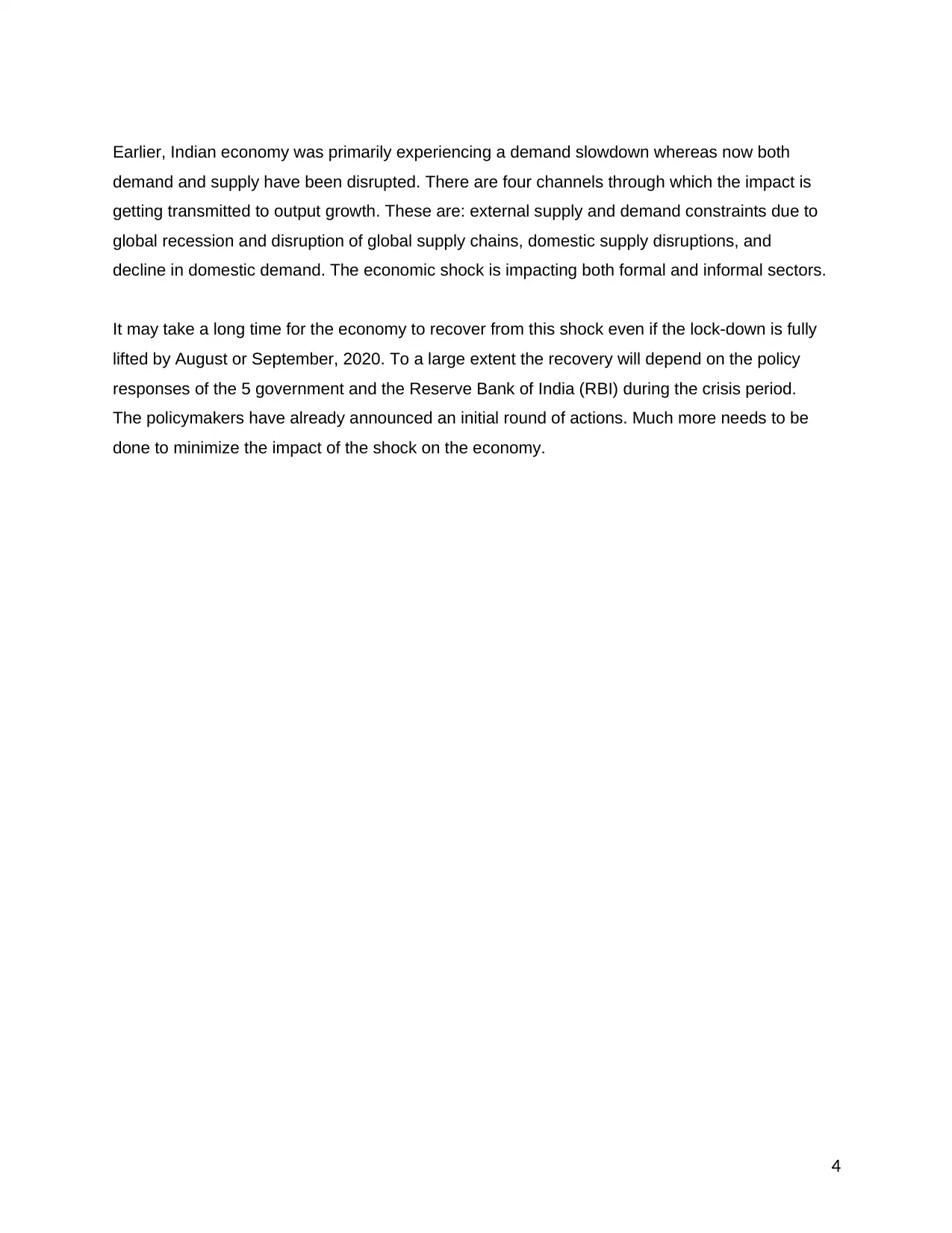
4
Earlier, Indian economy was primarily experiencing a demand slowdown whereas now both
demand and supply have been disrupted. There are four channels through which the impact is
getting transmitted to output growth. These are: external supply and demand constraints due to
global recession and disruption of global supply chains, domestic supply disruptions, and
decline in domestic demand. The economic shock is impacting both formal and informal sectors.
It may take a long time for the economy to recover from this shock even if the lock-down is fully
lifted by August or September, 2020. To a large extent the recovery will depend on the policy
responses of the 5 government and the Reserve Bank of India (RBI) during the crisis period.
The policymakers have already announced an initial round of actions. Much more needs to be
done to minimize the impact of the shock on the economy.
Earlier, Indian economy was primarily experiencing a demand slowdown whereas now both
demand and supply have been disrupted. There are four channels through which the impact is
getting transmitted to output growth. These are: external supply and demand constraints due to
global recession and disruption of global supply chains, domestic supply disruptions, and
decline in domestic demand. The economic shock is impacting both formal and informal sectors.
It may take a long time for the economy to recover from this shock even if the lock-down is fully
lifted by August or September, 2020. To a large extent the recovery will depend on the policy
responses of the 5 government and the Reserve Bank of India (RBI) during the crisis period.
The policymakers have already announced an initial round of actions. Much more needs to be
done to minimize the impact of the shock on the economy.
Paraphrase This Document
Need a fresh take? Get an instant paraphrase of this document with our AI Paraphraser
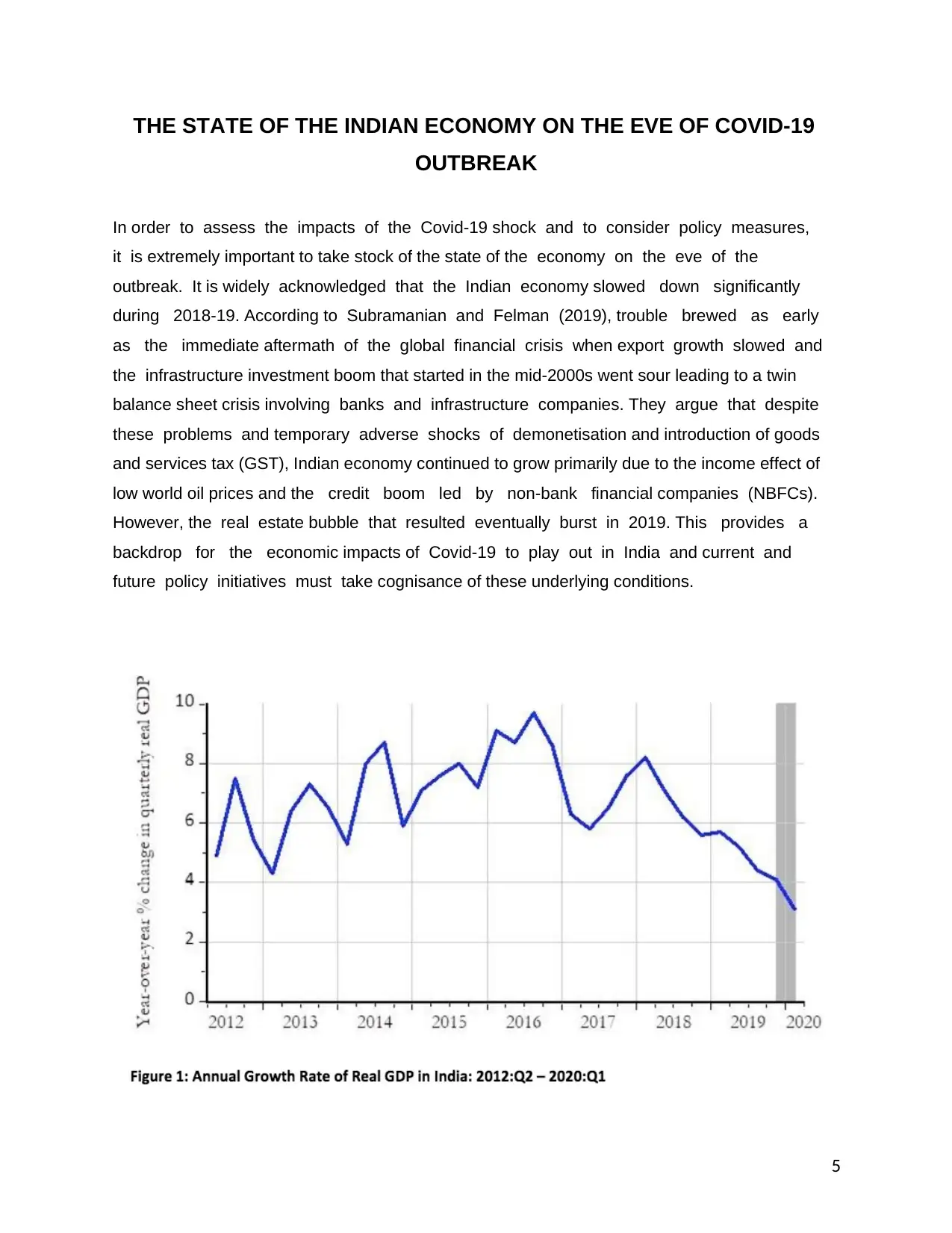
5
THE STATE OF THE INDIAN ECONOMY ON THE EVE OF COVID-19
OUTBREAK
In order to assess the impacts of the Covid-19 shock and to consider policy measures,
it is extremely important to take stock of the state of the economy on the eve of the
outbreak. It is widely acknowledged that the Indian economy slowed down significantly
during 2018-19. According to Subramanian and Felman (2019), trouble brewed as early
as the immediate aftermath of the global financial crisis when export growth slowed and
the infrastructure investment boom that started in the mid-2000s went sour leading to a twin
balance sheet crisis involving banks and infrastructure companies. They argue that despite
these problems and temporary adverse shocks of demonetisation and introduction of goods
and services tax (GST), Indian economy continued to grow primarily due to the income effect of
low world oil prices and the credit boom led by non-bank financial companies (NBFCs).
However, the real estate bubble that resulted eventually burst in 2019. This provides a
backdrop for the economic impacts of Covid-19 to play out in India and current and
future policy initiatives must take cognisance of these underlying conditions.
THE STATE OF THE INDIAN ECONOMY ON THE EVE OF COVID-19
OUTBREAK
In order to assess the impacts of the Covid-19 shock and to consider policy measures,
it is extremely important to take stock of the state of the economy on the eve of the
outbreak. It is widely acknowledged that the Indian economy slowed down significantly
during 2018-19. According to Subramanian and Felman (2019), trouble brewed as early
as the immediate aftermath of the global financial crisis when export growth slowed and
the infrastructure investment boom that started in the mid-2000s went sour leading to a twin
balance sheet crisis involving banks and infrastructure companies. They argue that despite
these problems and temporary adverse shocks of demonetisation and introduction of goods
and services tax (GST), Indian economy continued to grow primarily due to the income effect of
low world oil prices and the credit boom led by non-bank financial companies (NBFCs).
However, the real estate bubble that resulted eventually burst in 2019. This provides a
backdrop for the economic impacts of Covid-19 to play out in India and current and
future policy initiatives must take cognisance of these underlying conditions.
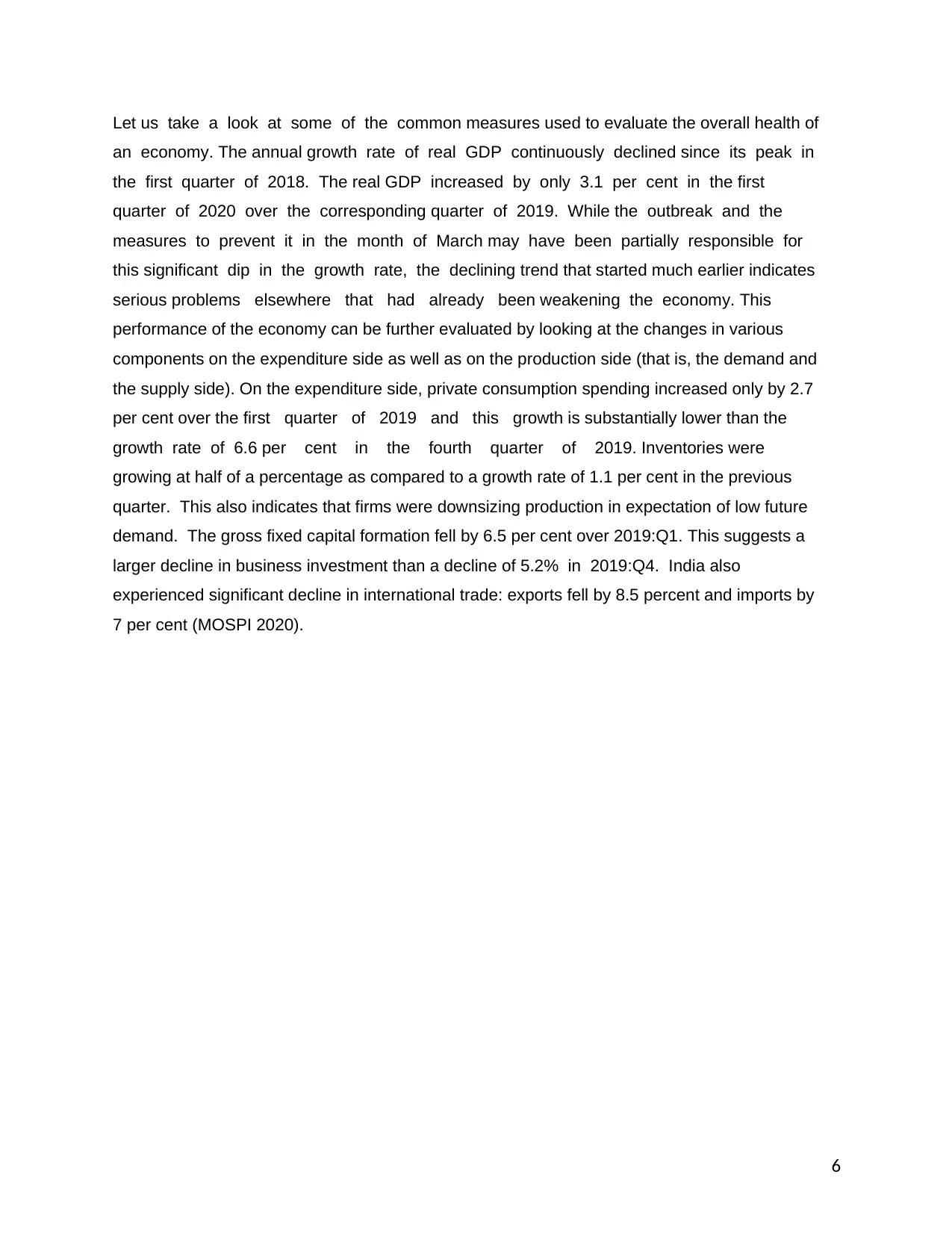
6
Let us take a look at some of the common measures used to evaluate the overall health of
an economy. The annual growth rate of real GDP continuously declined since its peak in
the first quarter of 2018. The real GDP increased by only 3.1 per cent in the first
quarter of 2020 over the corresponding quarter of 2019. While the outbreak and the
measures to prevent it in the month of March may have been partially responsible for
this significant dip in the growth rate, the declining trend that started much earlier indicates
serious problems elsewhere that had already been weakening the economy. This
performance of the economy can be further evaluated by looking at the changes in various
components on the expenditure side as well as on the production side (that is, the demand and
the supply side). On the expenditure side, private consumption spending increased only by 2.7
per cent over the first quarter of 2019 and this growth is substantially lower than the
growth rate of 6.6 per cent in the fourth quarter of 2019. Inventories were
growing at half of a percentage as compared to a growth rate of 1.1 per cent in the previous
quarter. This also indicates that firms were downsizing production in expectation of low future
demand. The gross fixed capital formation fell by 6.5 per cent over 2019:Q1. This suggests a
larger decline in business investment than a decline of 5.2% in 2019:Q4. India also
experienced significant decline in international trade: exports fell by 8.5 percent and imports by
7 per cent (MOSPI 2020).
Let us take a look at some of the common measures used to evaluate the overall health of
an economy. The annual growth rate of real GDP continuously declined since its peak in
the first quarter of 2018. The real GDP increased by only 3.1 per cent in the first
quarter of 2020 over the corresponding quarter of 2019. While the outbreak and the
measures to prevent it in the month of March may have been partially responsible for
this significant dip in the growth rate, the declining trend that started much earlier indicates
serious problems elsewhere that had already been weakening the economy. This
performance of the economy can be further evaluated by looking at the changes in various
components on the expenditure side as well as on the production side (that is, the demand and
the supply side). On the expenditure side, private consumption spending increased only by 2.7
per cent over the first quarter of 2019 and this growth is substantially lower than the
growth rate of 6.6 per cent in the fourth quarter of 2019. Inventories were
growing at half of a percentage as compared to a growth rate of 1.1 per cent in the previous
quarter. This also indicates that firms were downsizing production in expectation of low future
demand. The gross fixed capital formation fell by 6.5 per cent over 2019:Q1. This suggests a
larger decline in business investment than a decline of 5.2% in 2019:Q4. India also
experienced significant decline in international trade: exports fell by 8.5 percent and imports by
7 per cent (MOSPI 2020).
⊘ This is a preview!⊘
Do you want full access?
Subscribe today to unlock all pages.

Trusted by 1+ million students worldwide
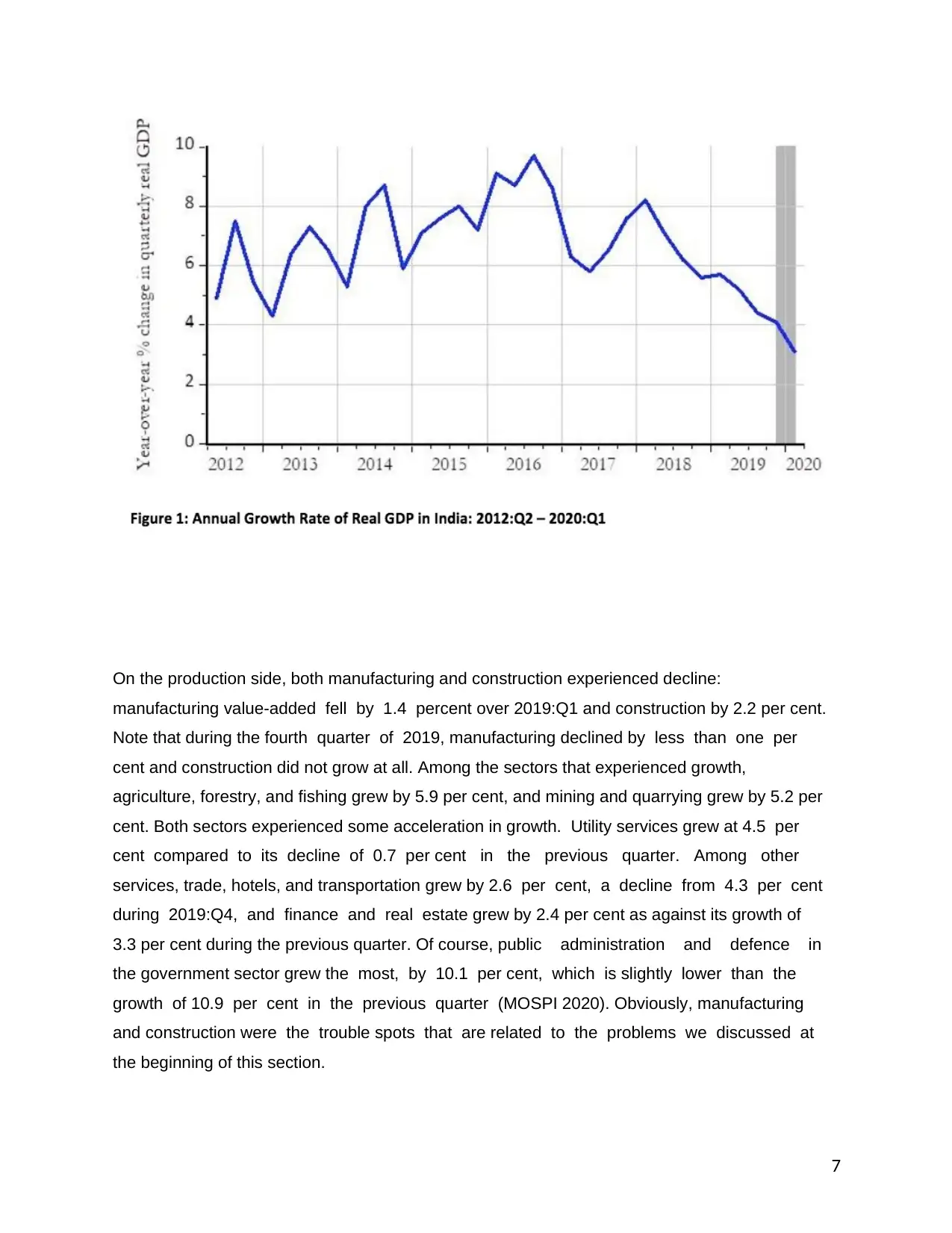
7
On the production side, both manufacturing and construction experienced decline:
manufacturing value-added fell by 1.4 percent over 2019:Q1 and construction by 2.2 per cent.
Note that during the fourth quarter of 2019, manufacturing declined by less than one per
cent and construction did not grow at all. Among the sectors that experienced growth,
agriculture, forestry, and fishing grew by 5.9 per cent, and mining and quarrying grew by 5.2 per
cent. Both sectors experienced some acceleration in growth. Utility services grew at 4.5 per
cent compared to its decline of 0.7 per cent in the previous quarter. Among other
services, trade, hotels, and transportation grew by 2.6 per cent, a decline from 4.3 per cent
during 2019:Q4, and finance and real estate grew by 2.4 per cent as against its growth of
3.3 per cent during the previous quarter. Of course, public administration and defence in
the government sector grew the most, by 10.1 per cent, which is slightly lower than the
growth of 10.9 per cent in the previous quarter (MOSPI 2020). Obviously, manufacturing
and construction were the trouble spots that are related to the problems we discussed at
the beginning of this section.
On the production side, both manufacturing and construction experienced decline:
manufacturing value-added fell by 1.4 percent over 2019:Q1 and construction by 2.2 per cent.
Note that during the fourth quarter of 2019, manufacturing declined by less than one per
cent and construction did not grow at all. Among the sectors that experienced growth,
agriculture, forestry, and fishing grew by 5.9 per cent, and mining and quarrying grew by 5.2 per
cent. Both sectors experienced some acceleration in growth. Utility services grew at 4.5 per
cent compared to its decline of 0.7 per cent in the previous quarter. Among other
services, trade, hotels, and transportation grew by 2.6 per cent, a decline from 4.3 per cent
during 2019:Q4, and finance and real estate grew by 2.4 per cent as against its growth of
3.3 per cent during the previous quarter. Of course, public administration and defence in
the government sector grew the most, by 10.1 per cent, which is slightly lower than the
growth of 10.9 per cent in the previous quarter (MOSPI 2020). Obviously, manufacturing
and construction were the trouble spots that are related to the problems we discussed at
the beginning of this section.
Paraphrase This Document
Need a fresh take? Get an instant paraphrase of this document with our AI Paraphraser
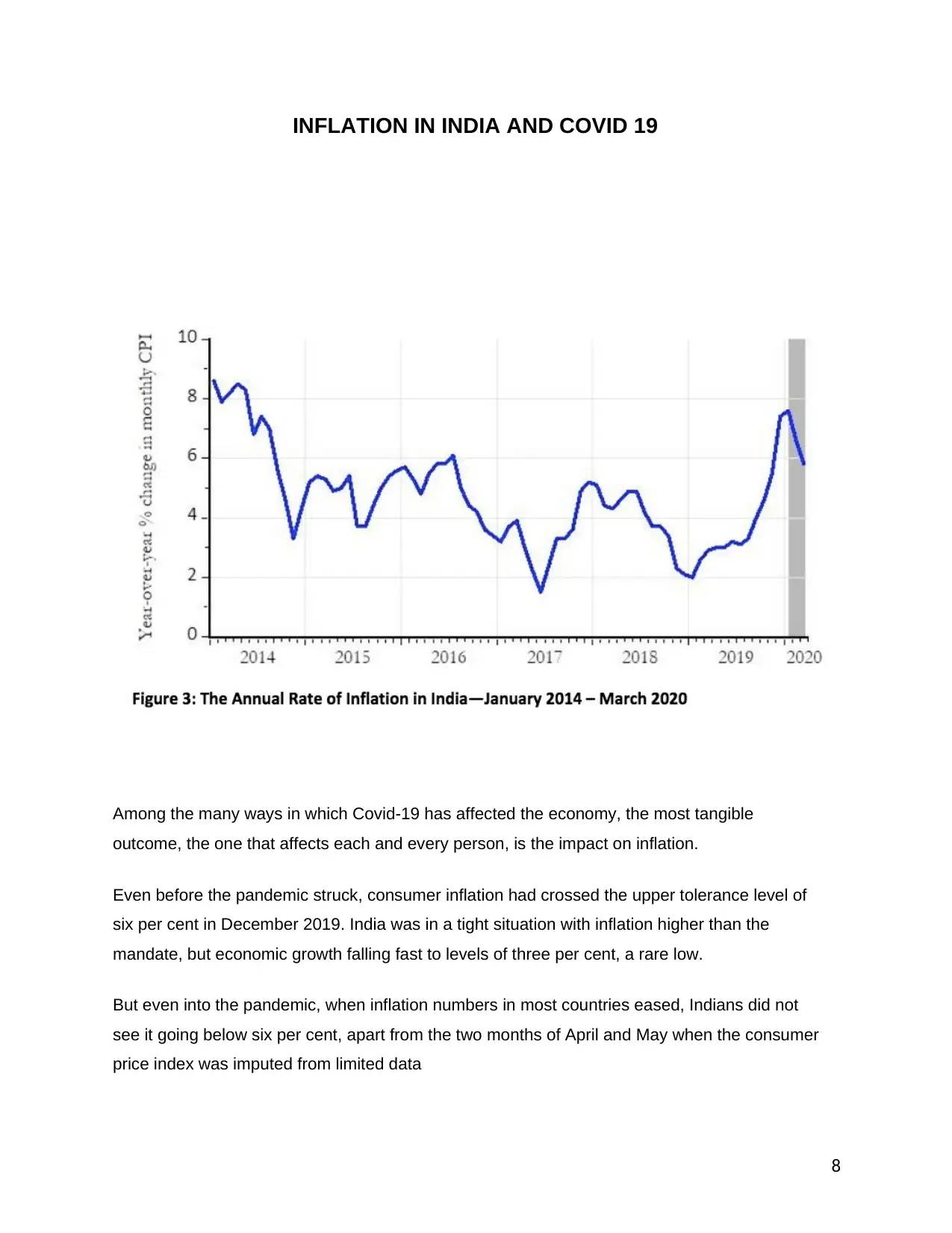
8
INFLATION IN INDIA AND COVID 19
Among the many ways in which Covid-19 has affected the economy, the most tangible
outcome, the one that affects each and every person, is the impact on inflation.
Even before the pandemic struck, consumer inflation had crossed the upper tolerance level of
six per cent in December 2019. India was in a tight situation with inflation higher than the
mandate, but economic growth falling fast to levels of three per cent, a rare low.
But even into the pandemic, when inflation numbers in most countries eased, Indians did not
see it going below six per cent, apart from the two months of April and May when the consumer
price index was imputed from limited data
INFLATION IN INDIA AND COVID 19
Among the many ways in which Covid-19 has affected the economy, the most tangible
outcome, the one that affects each and every person, is the impact on inflation.
Even before the pandemic struck, consumer inflation had crossed the upper tolerance level of
six per cent in December 2019. India was in a tight situation with inflation higher than the
mandate, but economic growth falling fast to levels of three per cent, a rare low.
But even into the pandemic, when inflation numbers in most countries eased, Indians did not
see it going below six per cent, apart from the two months of April and May when the consumer
price index was imputed from limited data
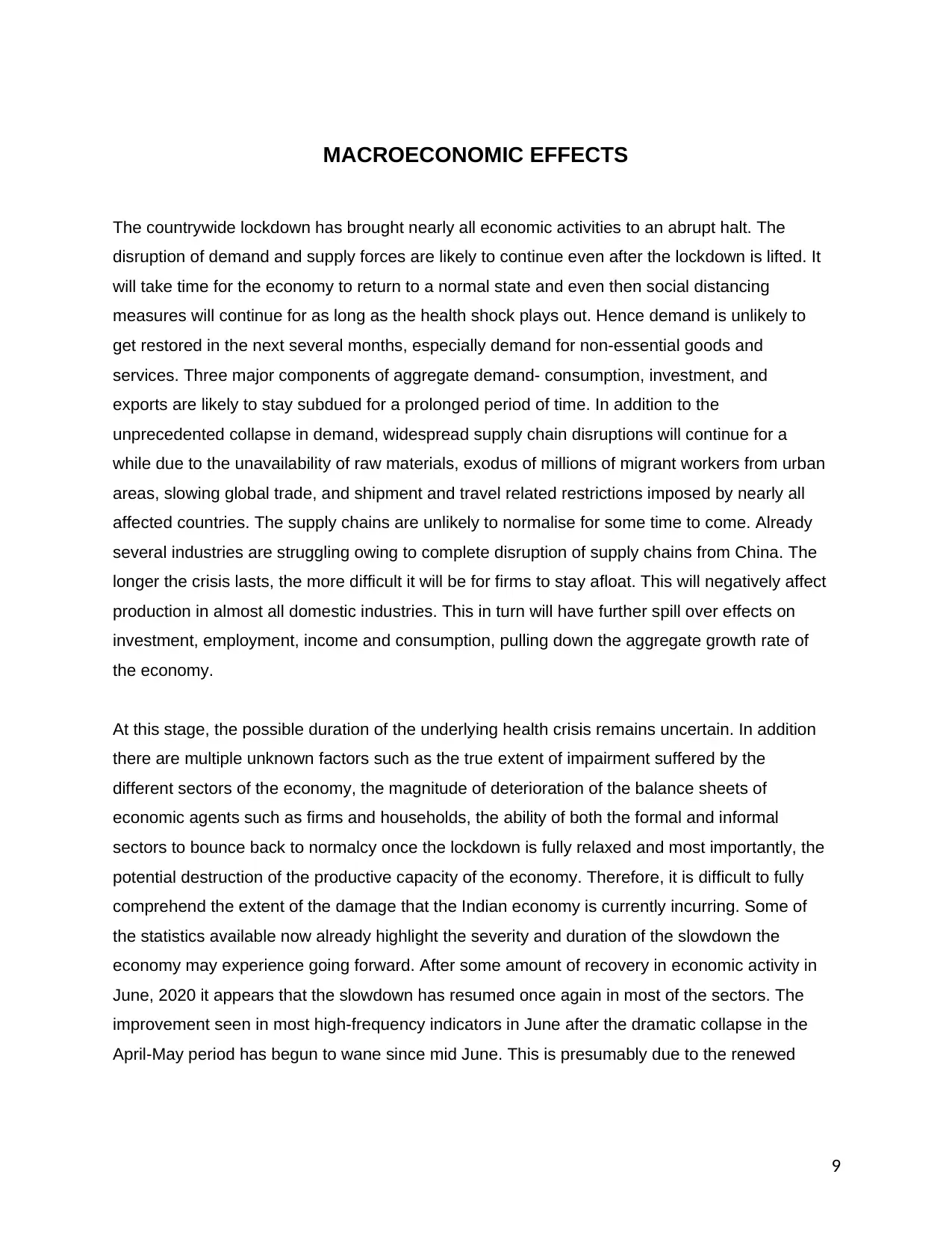
9
MACROECONOMIC EFFECTS
The countrywide lockdown has brought nearly all economic activities to an abrupt halt. The
disruption of demand and supply forces are likely to continue even after the lockdown is lifted. It
will take time for the economy to return to a normal state and even then social distancing
measures will continue for as long as the health shock plays out. Hence demand is unlikely to
get restored in the next several months, especially demand for non-essential goods and
services. Three major components of aggregate demand- consumption, investment, and
exports are likely to stay subdued for a prolonged period of time. In addition to the
unprecedented collapse in demand, widespread supply chain disruptions will continue for a
while due to the unavailability of raw materials, exodus of millions of migrant workers from urban
areas, slowing global trade, and shipment and travel related restrictions imposed by nearly all
affected countries. The supply chains are unlikely to normalise for some time to come. Already
several industries are struggling owing to complete disruption of supply chains from China. The
longer the crisis lasts, the more difficult it will be for firms to stay afloat. This will negatively affect
production in almost all domestic industries. This in turn will have further spill over effects on
investment, employment, income and consumption, pulling down the aggregate growth rate of
the economy.
At this stage, the possible duration of the underlying health crisis remains uncertain. In addition
there are multiple unknown factors such as the true extent of impairment suffered by the
different sectors of the economy, the magnitude of deterioration of the balance sheets of
economic agents such as firms and households, the ability of both the formal and informal
sectors to bounce back to normalcy once the lockdown is fully relaxed and most importantly, the
potential destruction of the productive capacity of the economy. Therefore, it is difficult to fully
comprehend the extent of the damage that the Indian economy is currently incurring. Some of
the statistics available now already highlight the severity and duration of the slowdown the
economy may experience going forward. After some amount of recovery in economic activity in
June, 2020 it appears that the slowdown has resumed once again in most of the sectors. The
improvement seen in most high-frequency indicators in June after the dramatic collapse in the
April-May period has begun to wane since mid June. This is presumably due to the renewed
MACROECONOMIC EFFECTS
The countrywide lockdown has brought nearly all economic activities to an abrupt halt. The
disruption of demand and supply forces are likely to continue even after the lockdown is lifted. It
will take time for the economy to return to a normal state and even then social distancing
measures will continue for as long as the health shock plays out. Hence demand is unlikely to
get restored in the next several months, especially demand for non-essential goods and
services. Three major components of aggregate demand- consumption, investment, and
exports are likely to stay subdued for a prolonged period of time. In addition to the
unprecedented collapse in demand, widespread supply chain disruptions will continue for a
while due to the unavailability of raw materials, exodus of millions of migrant workers from urban
areas, slowing global trade, and shipment and travel related restrictions imposed by nearly all
affected countries. The supply chains are unlikely to normalise for some time to come. Already
several industries are struggling owing to complete disruption of supply chains from China. The
longer the crisis lasts, the more difficult it will be for firms to stay afloat. This will negatively affect
production in almost all domestic industries. This in turn will have further spill over effects on
investment, employment, income and consumption, pulling down the aggregate growth rate of
the economy.
At this stage, the possible duration of the underlying health crisis remains uncertain. In addition
there are multiple unknown factors such as the true extent of impairment suffered by the
different sectors of the economy, the magnitude of deterioration of the balance sheets of
economic agents such as firms and households, the ability of both the formal and informal
sectors to bounce back to normalcy once the lockdown is fully relaxed and most importantly, the
potential destruction of the productive capacity of the economy. Therefore, it is difficult to fully
comprehend the extent of the damage that the Indian economy is currently incurring. Some of
the statistics available now already highlight the severity and duration of the slowdown the
economy may experience going forward. After some amount of recovery in economic activity in
June, 2020 it appears that the slowdown has resumed once again in most of the sectors. The
improvement seen in most high-frequency indicators in June after the dramatic collapse in the
April-May period has begun to wane since mid June. This is presumably due to the renewed
⊘ This is a preview!⊘
Do you want full access?
Subscribe today to unlock all pages.

Trusted by 1+ million students worldwide
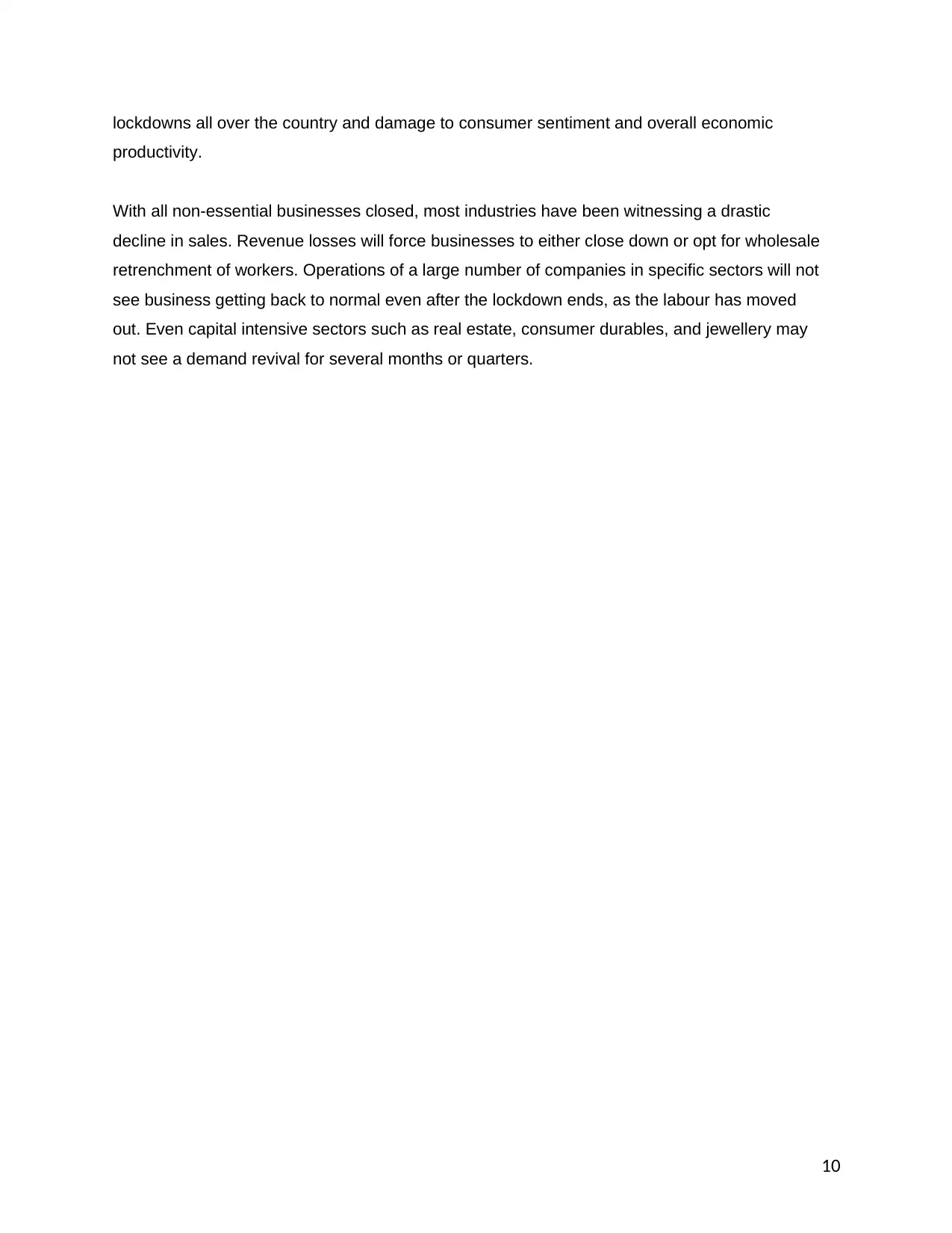
10
lockdowns all over the country and damage to consumer sentiment and overall economic
productivity.
With all non-essential businesses closed, most industries have been witnessing a drastic
decline in sales. Revenue losses will force businesses to either close down or opt for wholesale
retrenchment of workers. Operations of a large number of companies in specific sectors will not
see business getting back to normal even after the lockdown ends, as the labour has moved
out. Even capital intensive sectors such as real estate, consumer durables, and jewellery may
not see a demand revival for several months or quarters.
lockdowns all over the country and damage to consumer sentiment and overall economic
productivity.
With all non-essential businesses closed, most industries have been witnessing a drastic
decline in sales. Revenue losses will force businesses to either close down or opt for wholesale
retrenchment of workers. Operations of a large number of companies in specific sectors will not
see business getting back to normal even after the lockdown ends, as the labour has moved
out. Even capital intensive sectors such as real estate, consumer durables, and jewellery may
not see a demand revival for several months or quarters.
Paraphrase This Document
Need a fresh take? Get an instant paraphrase of this document with our AI Paraphraser
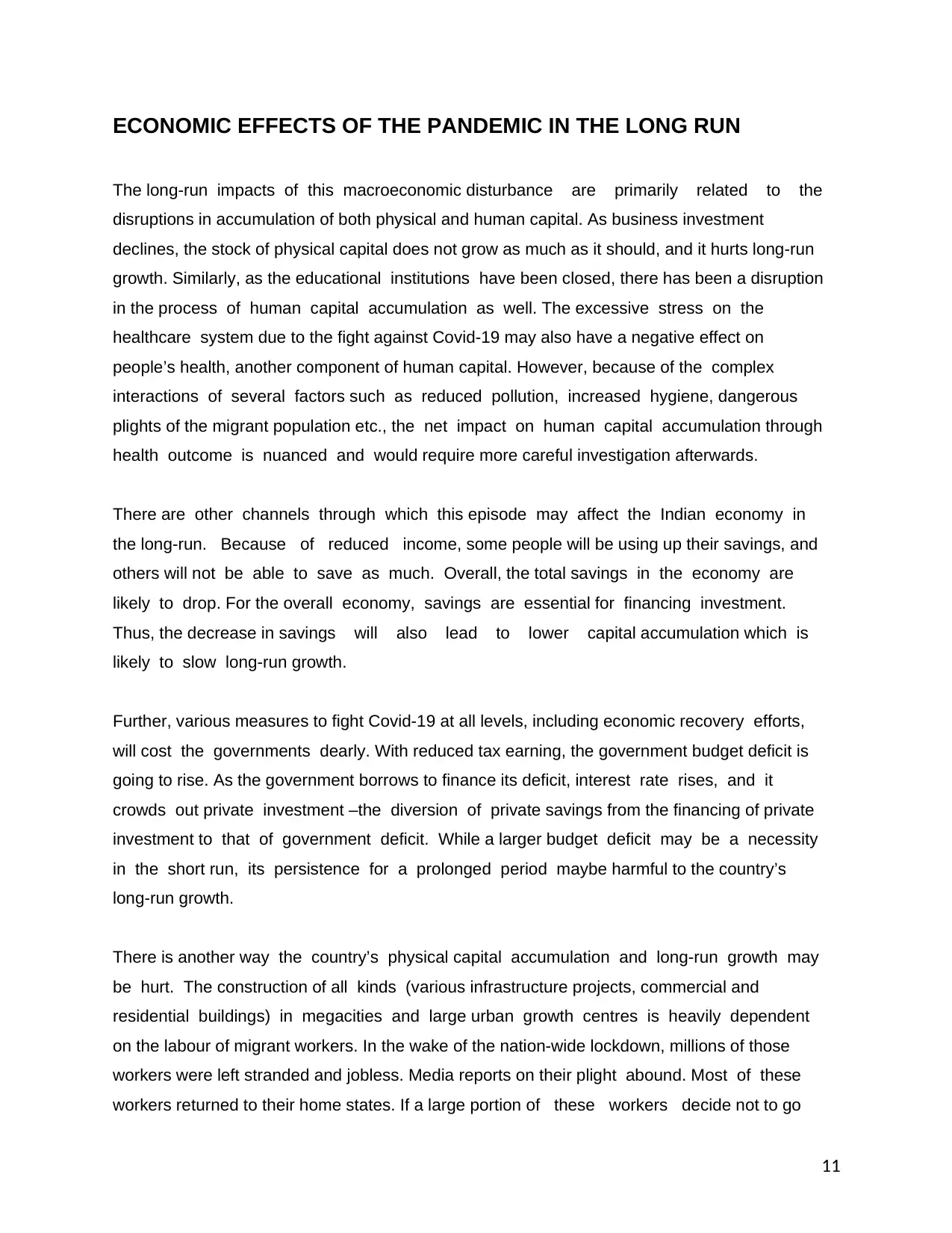
11
ECONOMIC EFFECTS OF THE PANDEMIC IN THE LONG RUN
The long-run impacts of this macroeconomic disturbance are primarily related to the
disruptions in accumulation of both physical and human capital. As business investment
declines, the stock of physical capital does not grow as much as it should, and it hurts long-run
growth. Similarly, as the educational institutions have been closed, there has been a disruption
in the process of human capital accumulation as well. The excessive stress on the
healthcare system due to the fight against Covid-19 may also have a negative effect on
people’s health, another component of human capital. However, because of the complex
interactions of several factors such as reduced pollution, increased hygiene, dangerous
plights of the migrant population etc., the net impact on human capital accumulation through
health outcome is nuanced and would require more careful investigation afterwards.
There are other channels through which this episode may affect the Indian economy in
the long-run. Because of reduced income, some people will be using up their savings, and
others will not be able to save as much. Overall, the total savings in the economy are
likely to drop. For the overall economy, savings are essential for financing investment.
Thus, the decrease in savings will also lead to lower capital accumulation which is
likely to slow long-run growth.
Further, various measures to fight Covid-19 at all levels, including economic recovery efforts,
will cost the governments dearly. With reduced tax earning, the government budget deficit is
going to rise. As the government borrows to finance its deficit, interest rate rises, and it
crowds out private investment –the diversion of private savings from the financing of private
investment to that of government deficit. While a larger budget deficit may be a necessity
in the short run, its persistence for a prolonged period maybe harmful to the country’s
long-run growth.
There is another way the country’s physical capital accumulation and long-run growth may
be hurt. The construction of all kinds (various infrastructure projects, commercial and
residential buildings) in megacities and large urban growth centres is heavily dependent
on the labour of migrant workers. In the wake of the nation-wide lockdown, millions of those
workers were left stranded and jobless. Media reports on their plight abound. Most of these
workers returned to their home states. If a large portion of these workers decide not to go
ECONOMIC EFFECTS OF THE PANDEMIC IN THE LONG RUN
The long-run impacts of this macroeconomic disturbance are primarily related to the
disruptions in accumulation of both physical and human capital. As business investment
declines, the stock of physical capital does not grow as much as it should, and it hurts long-run
growth. Similarly, as the educational institutions have been closed, there has been a disruption
in the process of human capital accumulation as well. The excessive stress on the
healthcare system due to the fight against Covid-19 may also have a negative effect on
people’s health, another component of human capital. However, because of the complex
interactions of several factors such as reduced pollution, increased hygiene, dangerous
plights of the migrant population etc., the net impact on human capital accumulation through
health outcome is nuanced and would require more careful investigation afterwards.
There are other channels through which this episode may affect the Indian economy in
the long-run. Because of reduced income, some people will be using up their savings, and
others will not be able to save as much. Overall, the total savings in the economy are
likely to drop. For the overall economy, savings are essential for financing investment.
Thus, the decrease in savings will also lead to lower capital accumulation which is
likely to slow long-run growth.
Further, various measures to fight Covid-19 at all levels, including economic recovery efforts,
will cost the governments dearly. With reduced tax earning, the government budget deficit is
going to rise. As the government borrows to finance its deficit, interest rate rises, and it
crowds out private investment –the diversion of private savings from the financing of private
investment to that of government deficit. While a larger budget deficit may be a necessity
in the short run, its persistence for a prolonged period maybe harmful to the country’s
long-run growth.
There is another way the country’s physical capital accumulation and long-run growth may
be hurt. The construction of all kinds (various infrastructure projects, commercial and
residential buildings) in megacities and large urban growth centres is heavily dependent
on the labour of migrant workers. In the wake of the nation-wide lockdown, millions of those
workers were left stranded and jobless. Media reports on their plight abound. Most of these
workers returned to their home states. If a large portion of these workers decide not to go
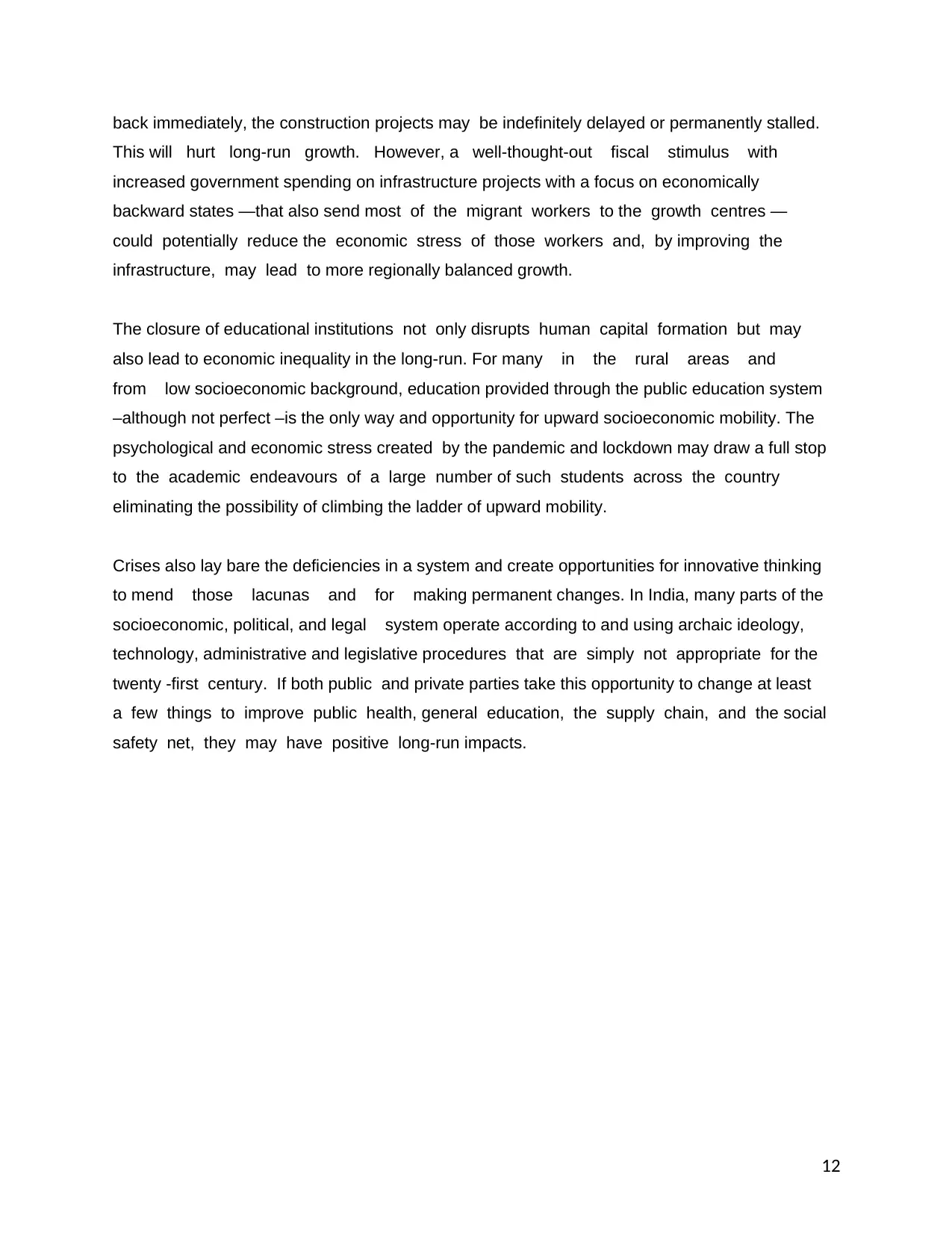
12
back immediately, the construction projects may be indefinitely delayed or permanently stalled.
This will hurt long-run growth. However, a well-thought-out fiscal stimulus with
increased government spending on infrastructure projects with a focus on economically
backward states —that also send most of the migrant workers to the growth centres —
could potentially reduce the economic stress of those workers and, by improving the
infrastructure, may lead to more regionally balanced growth.
The closure of educational institutions not only disrupts human capital formation but may
also lead to economic inequality in the long-run. For many in the rural areas and
from low socioeconomic background, education provided through the public education system
–although not perfect –is the only way and opportunity for upward socioeconomic mobility. The
psychological and economic stress created by the pandemic and lockdown may draw a full stop
to the academic endeavours of a large number of such students across the country
eliminating the possibility of climbing the ladder of upward mobility.
Crises also lay bare the deficiencies in a system and create opportunities for innovative thinking
to mend those lacunas and for making permanent changes. In India, many parts of the
socioeconomic, political, and legal system operate according to and using archaic ideology,
technology, administrative and legislative procedures that are simply not appropriate for the
twenty -first century. If both public and private parties take this opportunity to change at least
a few things to improve public health, general education, the supply chain, and the social
safety net, they may have positive long-run impacts.
back immediately, the construction projects may be indefinitely delayed or permanently stalled.
This will hurt long-run growth. However, a well-thought-out fiscal stimulus with
increased government spending on infrastructure projects with a focus on economically
backward states —that also send most of the migrant workers to the growth centres —
could potentially reduce the economic stress of those workers and, by improving the
infrastructure, may lead to more regionally balanced growth.
The closure of educational institutions not only disrupts human capital formation but may
also lead to economic inequality in the long-run. For many in the rural areas and
from low socioeconomic background, education provided through the public education system
–although not perfect –is the only way and opportunity for upward socioeconomic mobility. The
psychological and economic stress created by the pandemic and lockdown may draw a full stop
to the academic endeavours of a large number of such students across the country
eliminating the possibility of climbing the ladder of upward mobility.
Crises also lay bare the deficiencies in a system and create opportunities for innovative thinking
to mend those lacunas and for making permanent changes. In India, many parts of the
socioeconomic, political, and legal system operate according to and using archaic ideology,
technology, administrative and legislative procedures that are simply not appropriate for the
twenty -first century. If both public and private parties take this opportunity to change at least
a few things to improve public health, general education, the supply chain, and the social
safety net, they may have positive long-run impacts.
⊘ This is a preview!⊘
Do you want full access?
Subscribe today to unlock all pages.

Trusted by 1+ million students worldwide
1 out of 14
Related Documents
Your All-in-One AI-Powered Toolkit for Academic Success.
+13062052269
info@desklib.com
Available 24*7 on WhatsApp / Email
![[object Object]](/_next/static/media/star-bottom.7253800d.svg)
Unlock your academic potential
Copyright © 2020–2025 A2Z Services. All Rights Reserved. Developed and managed by ZUCOL.



